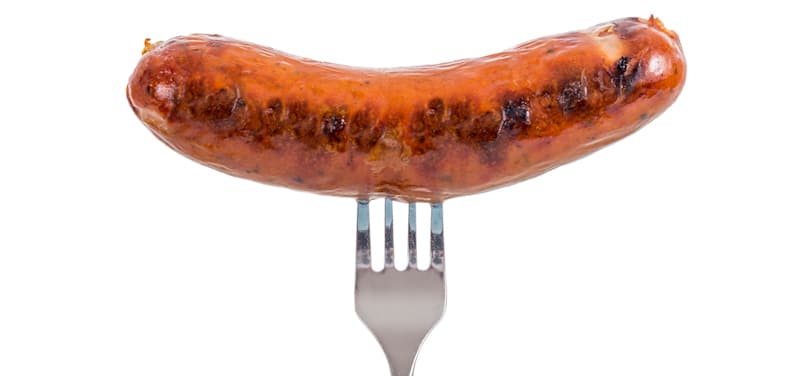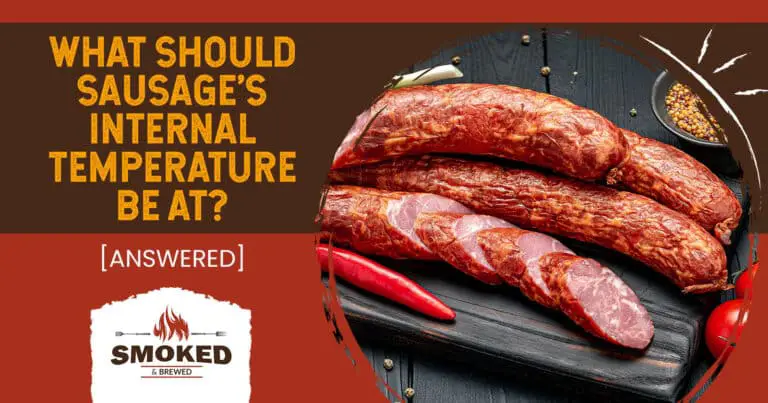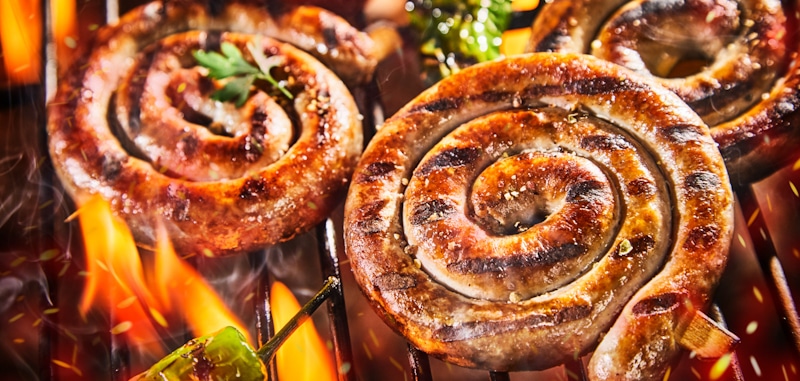Be it a satisfying English breakfast or a barbeque party; sausages are a staple dish for every meat lover. They are inexpensive, readily available, and easy to cook. But did you know that raw and undercooked sausages may actually be dangerous to eat?
Sausages must always be cooked at a standard minimum internal temperature, that is 160°F or 71°C for beef, pork, and lamb and 165°F or 74°C for chicken, duck, turkey, and game birds. High internal temperature cooks the meat perfectly and helps in killing several pathogenic bacteria, which are known to cause food-borne illnesses.
Sausages are made from ground pork, beef, chicken, and poultry and mixed with spices and flavorings. As easy as it sounds, perfectly cooked sausages that are free from harmful bacteria can actually be quite difficult to make. Cooking sausages at the right internal temperatures is one of the most popular methods to not only ensure that the juiciness of the meat is intact, but also safe and hygienic to consume.

Why Do You Need to Measure the Internal Temperature of Sausage?
Meat, especially ground pork, is prone to infection and can cause food poisoning and food-borne illnesses in humans. Undercooked pork sausages may contain parasites like Trichinella spiralis and worms, which can cause diarrhea, stomach cramps, muscle pain, fever, and other digestive distress. Likewise, poultry sausages may be contaminated with Salmonella and Clostridium perfringens. Proper processing and cooking is the only way to reduce the risk of such infections.
When sausages are cooked at the recommended temperatures, it is said to be ‘pasteurized’ – a process of partial sterilization of sausages to ensure that it is safe for consumption and to improve their preservation quality.
What Should The Internal Temperature Of Sausage Be?
Because sausages are one of the most popular and easily available ready-to-eat foods, several agencies across the world have recommended guidelines for following good manufacturing practices for sausage and ground meat production. The ideal cooking temperature for different types of sausages/ ground meat as prescribed by the USDA are:
- Pork, Beef, Veal, and Lamb Sausages – 71.1°C or 165°F
- Chicken, Duck, or Turkey (Poultry) and Game Birds Sausages – 73.8°C or 165°F.
Do remember that cooking the meat at a higher temperature than recommended will melt the fat and make the sausage taste drier and less juicy. Perishable foods like sausages that are left at 90°F to 140°F for more than an hour are not considered safe to eat.
How Is Sausage’s Internal Temperature Measured?
Sausages come in a variety of shapes, forms, and casings, and there is a logical method for checking the internal temperature for each. Pricking, inserting a fork, or checking the outside color are traditional methods for confirming whether the meat/ sausages are fully cooked. Experts say that these methods let the fats and juices escape from the meat and are not very reliable.
In today’s world, monitoring the internal temperature of sausages or ground meat can be done with more advanced, accurate, and reliable techniques – such as using an ‘instant-read thermometer,’ preferably a digital one. A food thermometer is one of the best methods to ensure that the food is fully cooked. Instant read thermometers give results within a few seconds.
The Method Explained:
For measuring the internal temperature, push the probes of the thermometer through the middle or thickest part of the sausage. This is because the thickest part is often the last to get cooked. For thin sausages or ground patties, insert sideways.
To avoid chances of error, the thermometer sensor should not touch any bone, gristle, or fat, especially when it comes to checking the internal temperatures of sausages made from game animals. This technique can be applied to grilled, roasted, or pan-fried sausages. If you have a large number of sausages, then measure random pieces to ensure that the entire set of meat is fully cooked.
Never place the thermometer into the sausage during cooking or grilling, as it may melt the device. You can check the internal temperatures towards the end of the cooking time and during the rest time. To reduce the chances of cross-contamination, make sure you thoroughly clean the thermometer with soap and water after every use.
How to Perfectly Cook Sausages?
The way you cook sausages not only alters the taste and texture, but it also changes the nutritional value. The best way to cook sausages is probably to first poach or simmer them in a liquid, followed by grilling on a hot skillet. Poaching raw sausages usually take about 30 minutes, whereas semi-cooked ones will take 10 minutes. Boiled or poached sausages are soft; however, they can be made crispier later by cooking them in a frying pan or a griller.
Burnt or blackened surfaces of sausages are a result of cooking in overly high heat. To avoid burning sausages, always follow the ‘low and slow process. Turn the sausages every minute or two, until they are golden brown on all sides. You can also pan-fry the meat over medium heat or roast them in an oven.
Grilling at high temperatures increases the volume of harmful compounds such as Polycyclic Aromatic Hydrocarbons (PAHs) and Heterocyclic Amines (HAs). These compounds are known to be carcinogenic agents.
Here is Gordon Ramsay’s guide to perfectly cooked sausages: https://www.youtube.com/watch?v=MDUipdbMqP8&t=103s.
The indirect dry heat roasting or grilling method not only cooks the meat perfectly but also gives a tempting deep caramelized texture. The butterfly method (slitting the sausage and laying the exposed part face down on the pan) works well with smoked or semi-cooked sausages.
If the sausages are perfectly cooked, they will be firm, juicy, and have a golden-brown or taupe-colored texture. Undercooked sausages are often left bloody on the inside, are soft to touch, and pink-colored.
The Importance of ‘Rest’ or ‘Carry Over’ Cooking Time
Before removing the sausages from the grill or the heat source, it is important to give about 3 to 5 minutes of ‘carryover cooking’ or ‘rest time’ before you cut and eat them. During this time, the residual heat in the sausage tenderizes the meat and helps keep the moisture and flavors intact. Since the temperature remains constant or continues to rise, the rest phase is also very important in destroying harmful bacteria.
Why Is The Internal Temperature Of Sausages Higher Than Whole Cuts of Pork?
The recommended temperature of safe-serving whole cuts is about 62°C or 145°F, which is quite lower than the sausage’s internal temperature. With a steak, you can easily sear the surface using high heat and kill all harmful pathogens. However, since sausages are ground meat (where surface bacteria can spread throughout), it becomes an easy host for microorganisms. Therefore, sausages and ground meat require proper curing with salt, acid, seasoning, and cooking at high heat, making it hard for bacteria to grow.
A Few Tips For Packed Sausages
Sausages are produced commercially on a large scale, and a plate of hearty and tasty sausages can fill a whole family quite inexpensively. However, before you open a pack of processed sausages or salami and toss them on a skillet, it is important to read the list of ingredients and check for any harmful preservatives. Also, be aware of the techniques used to manufacture, the source of meat, and of course, the best before date. Pre-cooked sausages that are not properly stored should never be purchased. Once the pack is opened, make sure you store the leftovers in a deep freezer and never keep it at room temperature for more than two hours.
Keep reading:
- Perfect Brisket Internal Temperature [SMOKING BRISKET]
- What’s the Best Griddle Temp for Burgers? [ANSWERED]
Scot has loved smoking food in his free time for the last few years. Each major holiday or off-weekend, Scot spends days testing and prepping new recipes for perfection.


